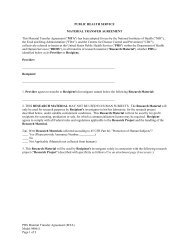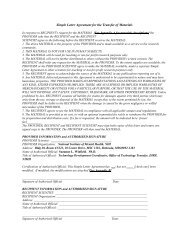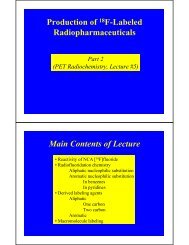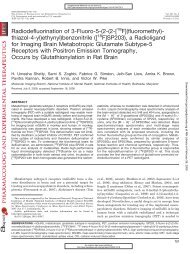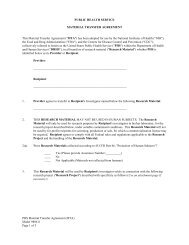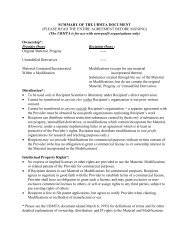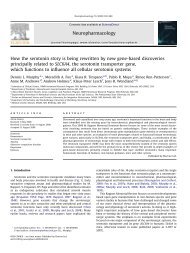Production of 18F-Labeled Radiopharmaceuticals
Production of 18F-Labeled Radiopharmaceuticals
Production of 18F-Labeled Radiopharmaceuticals
Create successful ePaper yourself
Turn your PDF publications into a flip-book with our unique Google optimized e-Paper software.
18 F -<br />
or<br />
Cs 18 F<br />
Wallach-type Reaction<br />
X<br />
N N N<br />
acid,<br />
heat<br />
• The decomposition <strong>of</strong> an aryltriazene by [ 18 F]hydrogen fluoride<br />
or anhydrous [ 18 F]caesium fluoride in acidic media, is<br />
used to prepare [ 18 F]fluoroarenes<br />
• Piperidinylaryltriazenes are <strong>of</strong>ten used<br />
• The method is regiospecific and NCA<br />
• An intermediate in the reaction scavenges all available anions<br />
giving various products including hydrogen-substituted<br />
product, leading to difficult separation<br />
• Yields tend to be very low except for simple substrates<br />
X<br />
18 F<br />
'Electrophilic' Radi<strong>of</strong>luorination<br />
-‘Electrophilic’ – its meaning with respect to fluorine<br />
• On thermodynamic grounds, the free electrophilic species F + is<br />
not recognised to exist in solution, even transiently<br />
• However, F bound to an electron-withdrawing group is <strong>of</strong>ten<br />
regarded as a source <strong>of</strong> F + , since such compounds <strong>of</strong>ten<br />
lead to the products expected from electrophilic addition<br />
or substitution in olefins and arenes, respectively<br />
• These reactions are frequently classed as ‘electrophilic’ even<br />
though this is not always justified by their possibly<br />
complex mechanisms<br />
• For convenience the term 'electrophilic' is used here to denote<br />
fluorinations giving the products expected from formally<br />
'electrophilic-type' additions or substitutions



